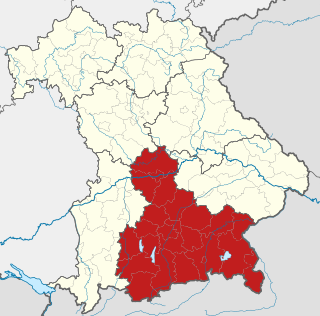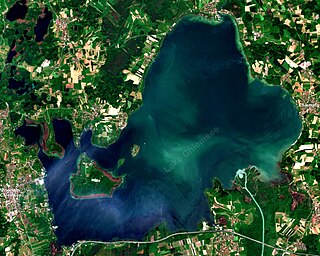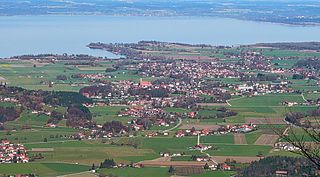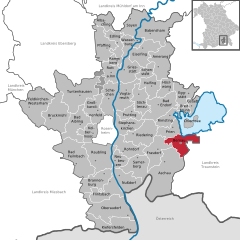Rosenheim is a Landkreis (district) in the south of Bavaria, Germany. Neighboring districts are, clockwise from the west, Miesbach, Munich, Ebersberg, Mühldorf, and Traunstein, with the Austrian province Tirol across the southern border. The district entirely surrounds the city of Rosenheim, which is independently administered but hosts the district's administration; both the city and the district share the "RO" designation for their license plates.

Upper Bavaria is one of the seven administrative districts of Bavaria, Germany.

Chiemsee is a freshwater lake in Bavaria, Germany, near Rosenheim. It is often called "the Bavarian Sea". The rivers Tiroler Achen and Prien flow into the lake from the south, and the river Alz flows out towards the north. The Alz flows into the Inn which then merges with the Danube. The Chiemsee is divided into the bigger, north section, in the northeast, called Weitsee, and the Inselsee, in the southwest.

Reit im Winkl is a small village located on the German/Austrian border in the southeastern part of Bavaria, Germany. Part of the Traunstein district, it was previously an immigration and customs control point. It is situated south of Chiemsee and southwest of Ruhpolding – home of the Biathlon World Cup – in the Bavarian Alps and facing towards Tyrol. The village lies next to the Austrian states Tyrol and Salzburg. Kössen in Tyrol is the next village on the river Lofer, before it joins the confluence of the river Tiroler Achen. Reit im Winkl has a population of approximately 2,600.

Prien am Chiemsee is a municipality in the Upper Bavarian district of Rosenheim in Germany. The town is a certified air and Kneipp spa on the western shore of the lake of Chiemsee, 16 kilometres (9.9 mi) east of Rosenheim.

Chiemgau is the common name of a geographic area in Upper Bavaria. It refers to the foothills of the Alps between the rivers Inn and Traun, with the Chiemsee at its center. The political districts that contain the Chiemgau are Rosenheim and Traunstein. Wendelstein is the name of a famous mountain close by but not strictly in the Chiemgau.

Gstadt am Chiemsee is a municipality and a village in the district of Rosenheim, Bavaria, Germany. It is located on Lake Chiemsee.

Übersee is a municipality and a village in the rural district of Traunstein in upper Bavaria, Germany. It lies on the south shore of lake Chiemsee.

Munich East station is a railway station in Munich, the state capital of Bavaria, Germany. It opened as Haidhausen station in 1871 on the new Munich–Mühldorf and Munich–Rosenheim railway lines. The station is operated by DB Station&Service, a subsidiary of Deutsche Bahn AG. It is classified as a Category 1 station, one of 21 in Germany and two in Munich, the other being München Hauptbahnhof. It is the city's third interregional station besides München Hauptbahnhof in the city centre and München-Pasing in the west.

Bad Endorf is a municipality and a village in the district of Rosenheim in Bavaria in Germany. The market town is located about 15 km outside of Rosenheim and is in close proximity to Lake Simssee and Chiemsee lake and its larger shore towns, Prien, Gstadt, and Seebruck.

Halfing is a municipality in the district of Rosenheim in Bavaria in Germany. It is located in the western part of the Chiemgau area, half-way between Chiemsee and Wasserburg am Inn.
The Tüttensee is a small lake in the Chiemgau region, the Bavarian Alpine foothills of the Traunstein district, within the municipalities of Grabenstätt and Vachendorf. With an area of 10.8 ha and a maximum depth of 17.3 m (57 ft), it is one of many Kettle-Lakes in the alpine foothills, that resulted from remnants of dead ice after a glacier retreated.

The Chiemgau Railway is a single-tracked, 9.6-kilometre-long (6.0 mi) railway line between Prien am Chiemsee and Aschau im Chiemgau in the state of Bavaria in southern Germany. It is timetabled as route no. 952.
Vachendorf is a village in the municipal district of the market town of Prien am Chiemsee in Landkreis Rosenheim in the state of Bavaria in southern Germany. It has about 55 inhabitants and lies centrally between the larger villages of Prien am Chiemsee, Bernau am Chiemsee, Frasdorf and Aschau im Chiemgau. Because of its proximity to the Chiemsee, Wildenwart Castle and a nature protection area, it is a favourite destination with the area for walkers.

The Deutsches Eck is the name given to the shortest and most convenient road and railway link between the Austrian metropolitan region of Salzburg and the Tyrolean Unterland with the state capital Innsbruck.
The Rosenheim–Salzburg railway is a continuous double track and electrified main line railway almost entirely within the German state of Bavaria. It is an international transport corridor, linking Rosenheim to Salzburg in Austria.

Prien am Chiemsee station is the largest station of the Bavarian market town of Prien am Chiemsee. The station was opened in 1860 and is classified by Deutsche Bahn as a category 4 station. It has four platform tracks, one of which is a bay platform. It is served by about 85 Deutsche Bahn trains each day. The station is a separation station and is located on the Rosenheim–Salzburg, Chiemgau Railway (Chiemgaubahn) and the Chiemsee Railway (Chiemseebahn).
Hainbach may refer to the following:

Bernau am Chiemsee station is a railway station in the municipality of Bernau am Chiemsee, located in the Rosenheim district in Bavaria, Germany.

























